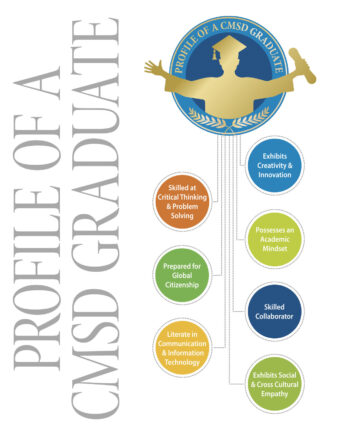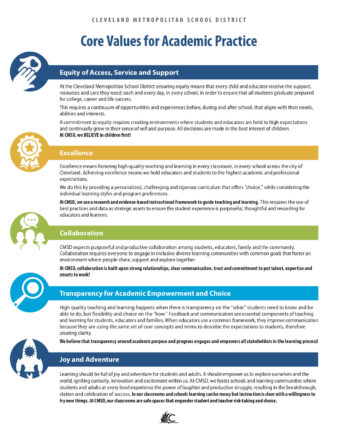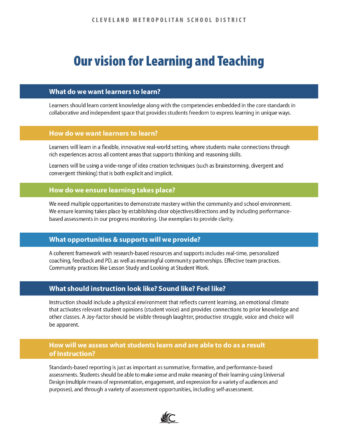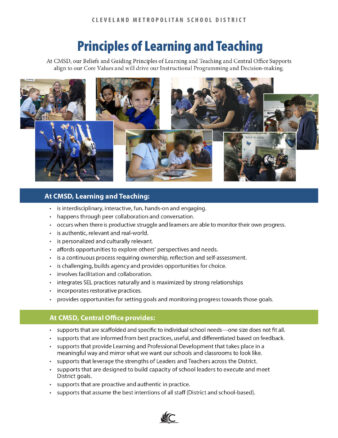An Urban District Reinvents Itself: Cleveland Metro Schools

Cleveland Metropolitan Schools (CMSD) is a district on the move. In this blogpost co-created with Chief Portfolio Officer Christine Fowler-Mack, we explore how Ohio’s second largest school district, serving almost 39,000 students, shifted gears before and during Coronavirus. We also look into how they may move forward differently as they go into the future.
This piece began to be developed before George Floyd’s murder and the events of the past several days. The work described below is Cleveland Metro Schools’ efforts to shift via the powerful lever of education the underlying structures that uphold racial injustice and poverty. Cleveland has the nation’s highest child poverty rate of any city over 250,000, the second highest poverty rate for working adults, and the third highest for older adults. 100% of the students in CMSD are economically disadvantaged, and 64.1% are black or African American. In the words of Christine Fowler-Mack, “There is a strong and compelling racial and social justice imperative behind our work to ensure equity and excellence. The children of Cleveland, more than half living in poverty, are depending on our system to deliver on the promise of them graduating career and college ready. Education has been embraced amongst the highest of priorities in our city, for its success is directly aligned to the potential for success and prosperity of our city and region.“
Cleveland Metro Schools has 100 different schools, including 40 high schools and 60 preK-8 or K-8s. In 2012 under the leadership of CEO Eric Gordon and with the support of Mayor Frank Jackson and the School Board, we began exploring a community-based reinvention of our entire system, beginning with high schools. Since then, twenty-three of the secondary schools have been redesigned to be mastery-based, which means that students progress in their learning journey as they demonstrate mastery of the material, not by sitting in seats for a certain number of hours over the course of a year. Two years ago, PK- and K-8s also began to explore redesign starting with a cohort of 13 schools.
The Pathway to High School Redesign
COMMUNITY ENGAGEMENT
Our redesign journey began in 2012-13 with a city-wide community engagement process run by technical assistance providers. This process lasted about three months and sought the perspectives of multiple stakeholders: students, parents, teachers, the business community. They came together at first in role-alike groups, though as they moved deeper into the design journey, the groups became more mixed and diverse.
The community engagement process resulted in the creation of our four design anchors or outputs:
- A district-wide profile of a graduate: what students should know and be able to do by the time they complete high school
- Values for an academic environment for schools that encompasses interaction with students
- A clear vision for what learning and teaching should look like in the district
- Principles for teaching and learning
IMPLEMENTATION PLANNING AND CHANGES
We then did an assessment of the condition of teaching and learning in the district and began Implementation planning.
Our first priorities were to build a common language around redesign throughout our high school stakeholder community. That meant socializing the redesign principles at scale and offering levels of training to build capacity in our stakeholder groups: principals, school-based leadership teams, the central office, and parents, all with different kinds of supports tailored to their needs and roles. We wanted our principals and leadership teams to be lead learners at their school sites–not the experts but those who could then grow the capacity of others even as they continued on their learning journeys. It was crucial for us to redesign our central office to support further learning and development of our new ways of doing things. We also wanted our parents to experience and embrace the language of our vision. Many of our parents can speak pretty fluently about the types of students we plan to graduate and the sorts of competencies they will have to thrive in a rapidly shifting world.
This process deeply changed how central office worked. We grouped our schools into networks, and then redesigned central office job descriptions and roles. The new roles were designed as problem solvers to school teams–we called them ‘partners’ who worked with school networks. To de-silo central office, we built cross-functional teams that cut across departments. To de-silo central office from school sites, we intentionally made sure the teams were disproportionately made up of principals who then brought in other stakeholders from their schools.
We approached capacity-building as learners; we designed for inquiry. What does mastery mean? What does research tell us? We created a toolbox–a treasure chest almost–with tools from districts around the country. Some districts excel in leadership development; we borrowed artifacts and tools from them. Others were strong in mastery-based learning, etc. We gathered from the best in class everywhere.
We have a few different approaches in play: some schools use Summit; others have done a lot of work to design performance tasks across multiple courses; others are themed schools– a digital arts school, a medical school using mastery approaches embedded in a hospitals, MC2 and other STEM schools. Further details on all this work can be found in our 2012-2016 Strategic Implementation Plan.
Last year we flattened the networks. Now we have just two high school networks. One has a heavier emphasis on Career Technical Education (CTE) and the other has a mastery-based approach to teaching and learning. There is some sharing across the networks, and we are looking to support more so that there can be less duplication of effort. Flattening multiple networks into two was one way to potentially increase the sharing of models and resources across schools.
Mastery-based PK- and K-8 Redesign
The high school work matured between 2013 and 2016, and as we continued to learn and grow from it, we were ready to design an even more powerful community-based process for our PK- and K-8 schools, 13 of whom entered into redesign in 2018. We had strongly come to believe that top-down, compliance-driven corrective action plans only achieved small upticks in improvement rather than transformational results. We chose to create a redesign process that put school communities in the driver’s seats because principals and their leadership teams, along with families and community partners, are best positioned to know the needs of their communities and which types of learning strategies and supports are needed. Like the high school redesign process, our K-8 process begins with an end goal in mind, a portrait of a graduate – what students should know and be able to do by the time they complete 8th grade.
School-based design teams of 8-10 open-minded, non-status-quo-oriented stakeholders led the effort. These teams were composed of:
- School principals
- School Cleveland Teachers Union chairs
- Teachers
- Non-teaching staff
- Parents
- Community members or potential school partners
We resourced them in a variety of ways: 1) through opportunities for school visits across the country so they could see new and different learning models in action; 2) a supportive, coherent design process with 12 specialized learning/design ‘clinics’ through the planning year as well as design templates that enabled them to clearly understand how to proceed; 3) a choice between three broad, open-ended models to adopt/adapt to their local context (inquiry-based learning, personalized learning, leadership development); and 4) technical assistance/partnership support both from the central office and external organizations. Our K-8 Redesign Guidebook with full details and templates is open-source.
This 2019-20 school year, those schools launched what they planned, and we were going to expand the work. We’ve come to embrace as a full community personalized, inquiry-oriented mastery for students, and we began this year with inquiry: what does it look like for a system to operationalize that fully?
Coronavirus!
Then COVID hit. Three months into it we look at our district’s bright spots and see that many of our portfolio schools–the ones that are moving through reinventing school–are doing the best, particularly the ones that are using mastery-based approaches. These schools already used blended learning. Teachers had already been thinking about student progressions. They had already been delving into growing student self-direction. Their instructional core–the curriculum, the teacher’s role within that, the role of the student–had already been (or begun to be) redesigned.
After Transcend and I spoke [Transcend Note: on a Friday afternoon at 4PM ET] I emailed my principals and asked, “What’s your best example of how the work of mastery has been beneficial during this time period?” These are some of the replies I received [Transcend Note: by Friday evening or first thing Saturday morning!]:
It’s said that there is an opportunity in every crisis and I have been so proud of the way that our faculty and students have seized this one to transform our learning environment. In response to COVID-19, we made the decision to deliver our curriculum to students through Instagram. Our thesis was that by getting into our students’ pockets and meeting them where they willingly spend much of their discretionary time, we could not only eliminate many barriers to entry, but engage them meaningfully during this period of disruption.
Since launching what we’re calling CHSDA InstaSchool on April 11th, we’ve been floored by the learning and creativity that this has unlocked for us as well as our students. We’ve found that by engaging our students using the same tools they use to express, inform, and entertain themselves, we are learning what it is to build a learning environment that speaks their native language. One way in which InstaSchool has contributed to our normal operations is in the way we’ve used Instagram Stories.
A typical day on InstaSchool begins with a wake up call, followed by a story laying out the day’s agenda. Another Story might pique his or her curiosity for an instructional video. Later in the day this student might tap into a live session where the teacher can help with any questions. That evening, after posting responses to guiding questions that focus on mastery skills, the student might be surprised by his or her work being showcased for the community. Our students have responded with great enthusiasm and the boost to learning and engagement despite the pandemic has been inspiring.
We are thinking very hard about how we can continue this deep engagement when we return to our building. At the very least, I think InstaSchool may replace certain PA announcements because I am able to reach students before they even arrive at the building. This saves instructional time and meets students wherever they are.
–Jasmine Maze, Principal, Cleveland School for the Digital Arts
As a mastery based school, students are accustomed to receiving feedback in lieu of traditional grades for assignments. Most of our classes are project based with checkpoints that lead to a final product. When each checkpoint is submitted, teachers provide feedback to each student before they continue moving through the project. When a final product is complete, students receive feedback and a score on each skill connected to the project. Students can also go back, revise and resubmit to increase their score. None of this is time bound; therefore, students could continue working on projects they had started and/or work on revisions as enrichment opportunities during the COVID 19 time period
In addition to projects, students can retake assessments. When they attempt an assessment and don’t receive a passing score, they get a breakdown of objectives that need to be reviewed. They can independently review their notes and other materials before attempting the assessment again. This cycle was able to continue with minimal disruption as we transitioned to remote learning.
–Tara Drouhard, Principal, Rhodes School of Environmental Studies
The mastery approach to learning has been incredibly beneficial during the Covid 19 school closure, in that, we have had to do very little shifting in our instruction. Before students left on March 13, they were already quite familiar with the steps they needed to take to improve their grades and the 5 mastery recovery options available for each learning outcome (1. Content repeat, 2. National exam/test out, 3. Alternate project, 4. Verbal Expression (video upload), 5. Self-designed project). While we miss our kids, they aren’t losing learning time, they are working without skipping a beat, AND, we haven’t had to make any other grading style adjustments that traditional grading schools have us to do.
Shifts will be needed, but post COVID our biggest changes will be social emotional. We need to be able to encourage collaborative work even at a distance, so students are able to continue to build 21st centers skills in a mastery system like ours.
–Feowyn MacKinnon (AKA Ms. MacK), Head of School, MC2 STEM High School
CODA: In the wake of Coronavirus CMSD is boldly considering moving all its schools towards mastery-based learning. To move in this direction, Christine Fowler-Mack offers the following insight: “We don’t want mastery to be viewed as something mysterious; it feels scary. We’re starting our journey by clarifying what constitutes good teaching and learning through an inquiry-oriented and personalized learning process. At the heart of it, we all fundamentally want mastery for our students. The challenges of the recent pandemic and social unrest should make us rethink how the practice of mastery, and reimagined educational practice in general, can impact society. While working on our understanding of the work itself, we understand that we will also need to deepen our engagement and capacity-building of teachers, students and their caregivers; each is so important to our success.”
Here is an example of a mastery model from Rhodes College and Career Academy.
Christine Fowler-Mack, Chief Portfolio Officer for CMSD, is an experienced, innovative and transformative leader in public education. She is one of the chief architects of The Plan for Transforming Cleveland’s Schools (The Cleveland Plan), a blueprint for reinventing public education in Cleveland. Fowler-Mack is a graduate of the first cohort of American Association of School Administrators and Howard University’s Urban Superintendent Program. She is also actively engaged in the Chiefs for Change, Future Chiefs collaborative.
Transcend supports communities to create and spread extraordinary, equitable learning environments.





